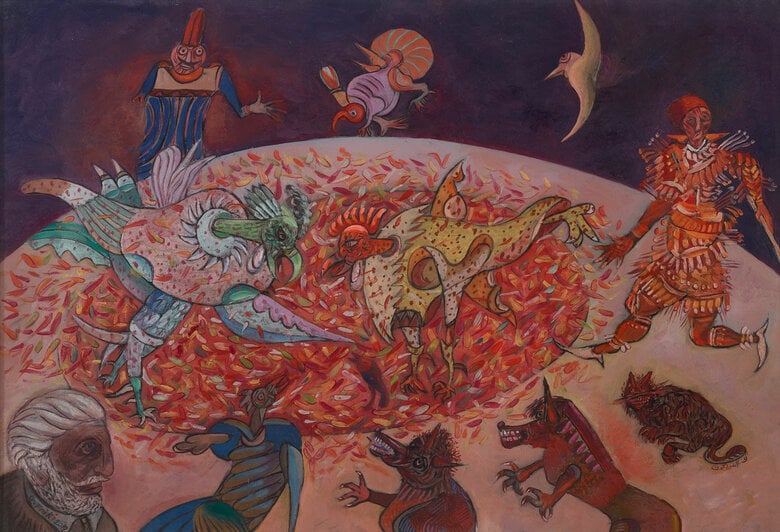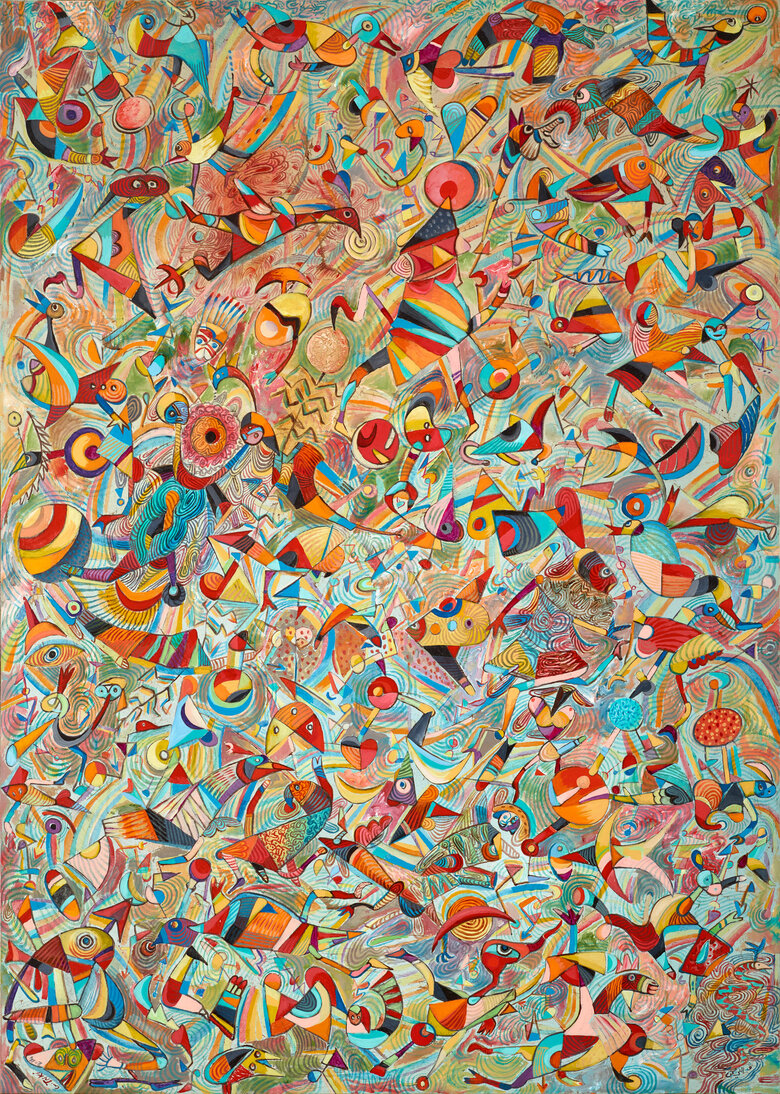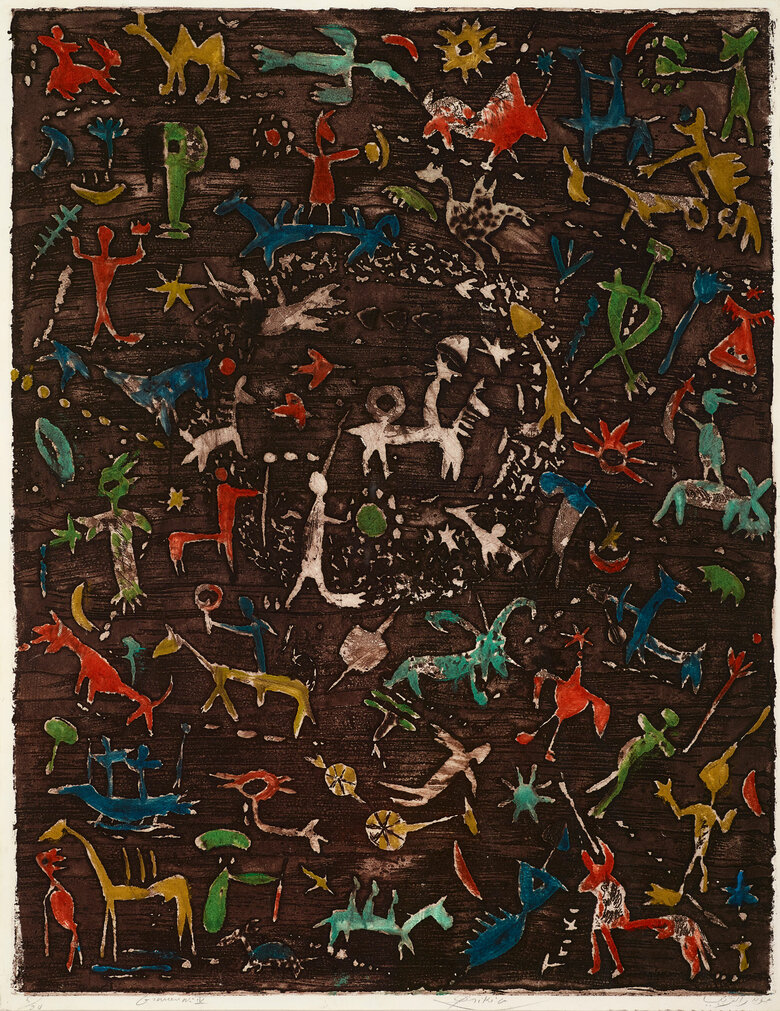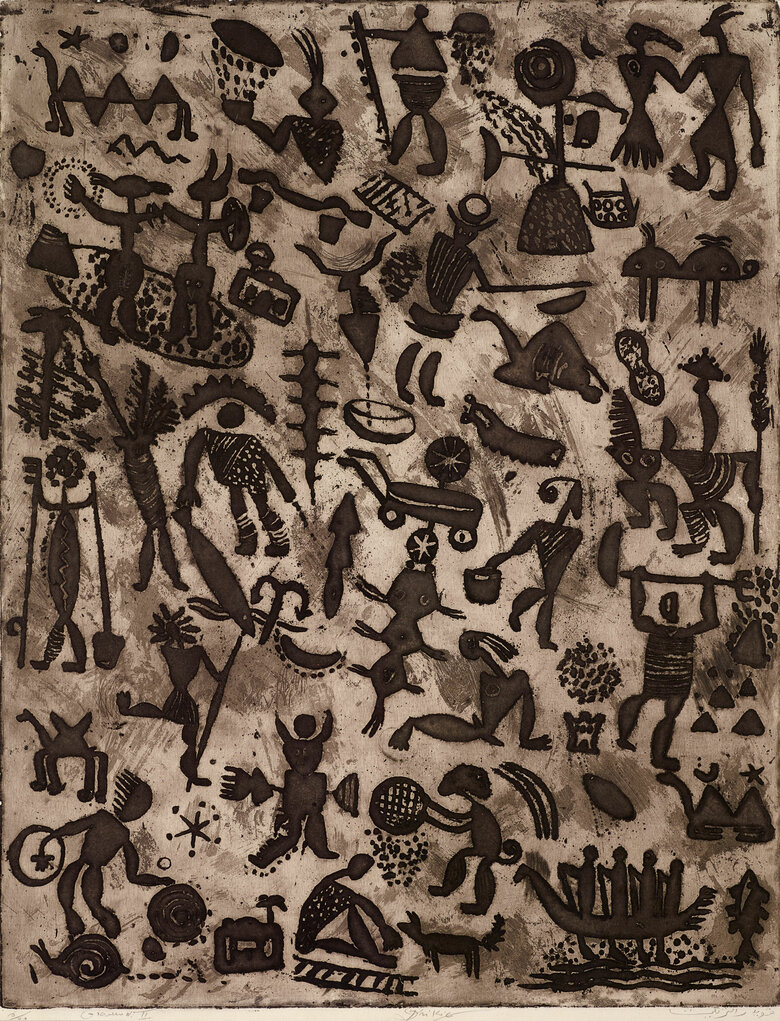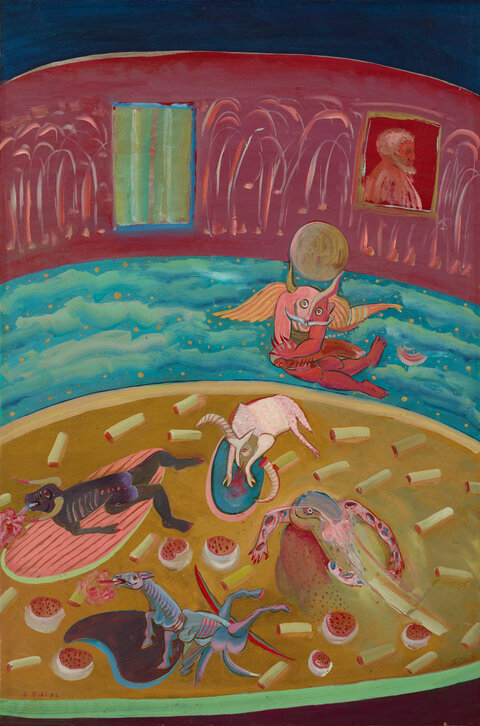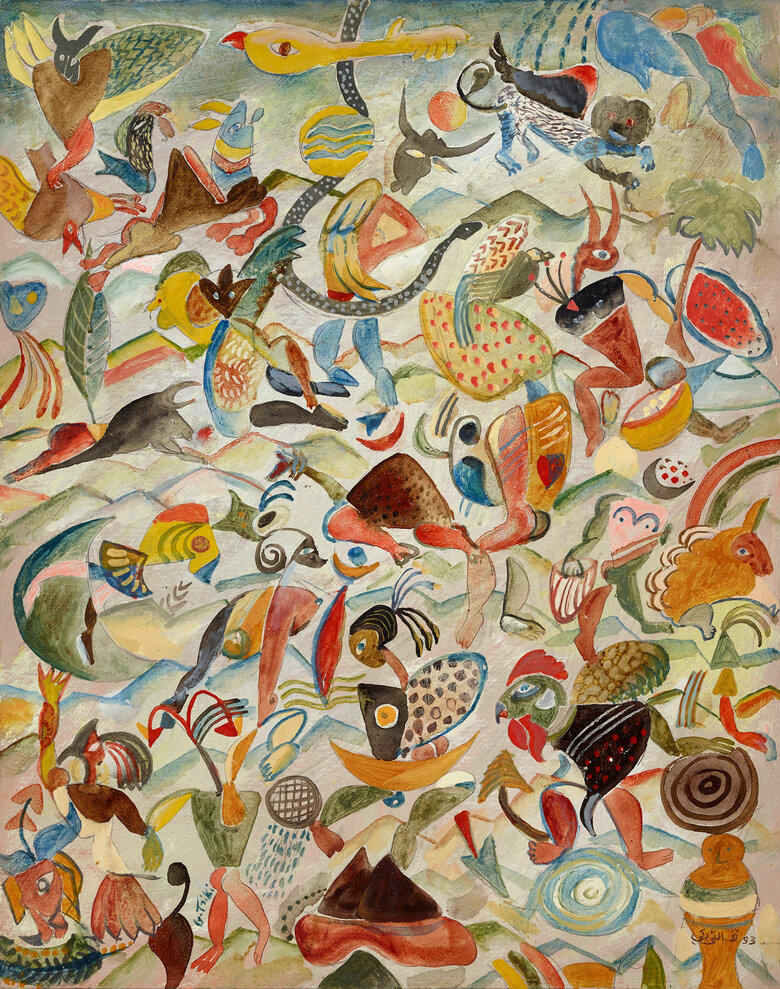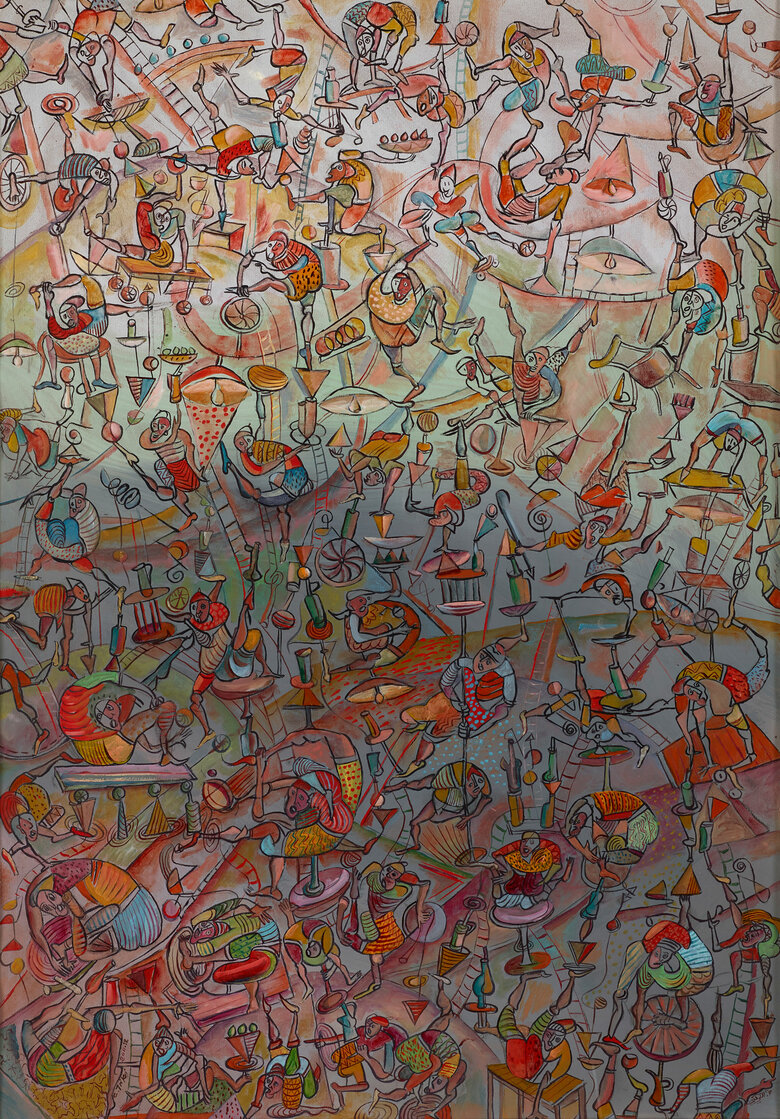Born in 1949 in Nabeul, Tunisia, Gouider Triki is a painter and engraver whose art draws extensively from symbols and motifs of different folklore traditions in the Maghreb. He received a diploma...
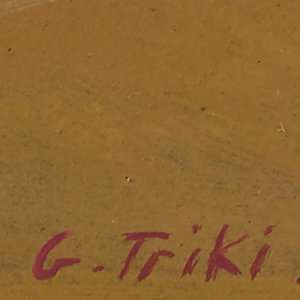

GOUIDER TRIKI, Tunisia (1949)
Bio
Written by MARIA LUNDERSKOV
Born in 1949 in Nabeul, Tunisia, Gouider Triki is a painter and engraver whose art draws extensively from symbols and motifs of different folklore traditions in the Maghreb. He received a diploma from the School of Fine Arts in Tunis in 1966, and continued his education at the School of Fine Arts in Paris from 1971 to 1974. Triki was then awarded a year-long internship from the International City of Arts in Paris[i].
During his time in Paris, Triki frequented the studios of local artists such as Jacques Lagrange (1917-1995), Lucien Coutaud (1904-1977), and Bertrand Borny (1931-2015), where he acquired skills in woodcut and wood engraving printmaking[ii]. Additionally, he was exposed to European art from the early 20th century. Triki was inspired by the Expressionist artists’ technique of using a combination of earthy and vibrant colors to convey varying emotions, and by the Surrealist artists’ mission to explore the human mind beyond rationalism, delving into the unconscious[iii].
After two decades of travelling and learning about art, he retired in the late 1980s to his hometown Lezdine, in northeastern Tunisia. There, he worked as a farmer and herdsman, experiences that enriched his reflections and work on the relation between humans and nature[iv].
Triki’s work is deeply rooted in the Amazigh (Berber) and Arab artistic traditions of the Maghreb, encompassing Tunisia, Algeria, Morocco, and parts of Egypt and Libya[v]. Throughout history, Maghreb art has blended indigenous Amazigh traditions with influences mainly from Arab, but also from Jewish, Andalusian, and various European cultures. Maghreb artistic tradition is notable for its mysticism, inspired by symbols and motifs rooted in Amazigh culture and the Islamic heritage brought to the region by Arabs in the 7th century[vi]. Over time, these symbols and motifs have been expressed through pottery, textiles, graphics, woodwork, leather crafts, jewelry, amulets, and tattoos. This fusion of Amazigh and Arabic Islamic tradition is evident in Triki´s work, in which he repeatedly used symbols such as the crescent and the spiral. While the former often symbolises the Islamic religion, the latter is used in Amazigh tattoos and jewelry to symbolise the eternal harmony of the cosmos[vii]. Triki’s motifs and aesthetic are also influenced by Fezzan and Tassili petroglyphs found respectively in Libya and Algeria, as well as the Neolithic paintings of Morocco[viii]. Furthermore, drawing on the Amazigh-Arab oral tradition of folk stories, Triki breathes life into imaginative hybrid figures[ix].
A major focus of Triki’s work is concerned with the structure of the world and the conditions of the elements that constitute it. His works feature two main structures: one constituted by pattern-like compositions, and another composed of sections often marked by curved lines. Both appear to represent aspects of the cosmos. The images, formed by a pattern with compositions that cover the entire pictorial space, are characterized by a myriad of details and a homogenous arrangement of the elements, conveying a sense of organized chaos. These images either resemble rural villages and human everyday life activities – playing, working the land, sailing, hunting, and dancing – or are composed of nets of floating creatures, formed by a mix of geometrical and organic shapes and figurative elements from nature. Rather than being subjects, in themselves, the figures in these images function as elements that, in relation to each other, form a cohesive whole. These images are created using pastel, charcoal, crayon, oil paint, gouache, or through the technique of engraving, resembling the action of scratching onto a hard surface like petroglyphs. An example is the colorful gouache and oil artwork, Untitled, 1993, which is part of the Ramzi and Saeda Dalloul Art Foundation (DAF) collection.
Untitled, 1993, appears to be composed of two overlapping layers. The first layer depicts a mountainous landscape with the sky above. The second layer features a tight woven carpet composed of animals, plants, humans, winged figures, graphic elements, and hybrid figures. Figurative elements from the Maghreb folklore are present, such as the palm tree symbolizing fertility and the lion symbolizing strength and courage[x]. Graphic elements like the crescent, circle, spiral, and triangle play various roles: they stand alone, compose figures, or support them, such as the human figure holding the crescent at the bottom left corner of the painting. Additionally, hybrid figures like the plant-like creature with a triangular upper body and human legs emerge from the intricate pattern on the bottom right corner. The artwork exudes a playful quality, engaging viewers to visualize or identify as many different figures as possible. The lack of a clear distinction between elements in the picture conveys the idea that we, as inhabitants of the world, are all part of the same natural system.
The images divided in sections often carry an allegorical meaning inspired by folktales about the relationship between various cosmic realms. They can be inhabited by few figures or exhibit areas with different patterns. An example is Untitled, 1997, also part of the DAF collection. The artwork is divided into three curved bands. The bottom band features anthropomorphic animal figures and meat-like elements against an ochre background. The figures’ bones are exposed, parts of their bodies are falling off, while they appear to be exhaling fiery blood. The middle band resembles clouds in a starry sky inhabited by a winged figure with horns holding a circular element reminiscent of the moon, and carrying a human figure in its arms. The top band contains a rectangle framing the profile of a bearded man recalling the figure of a Greek philosopher, possibly Plato, who worked extensively on finding the etymology of sophia (greek:σοφία - wisdom), or Plotinus, in whose philosophy sophia acquires a cosmological character[xi]. Differently from Untitled, 1993, this painting illustrates a hierarchy among the creatures of the cosmos, with the degeneration of the beasts at the bottom and the high intellect on the top.
In his representation of the cosmos, Triki often portrays bloody battles among the figures that compose it. One such example is Untitled, 2011, also part of the DAF collection. It features a cockfight atop a rounded surface resembling the Earth’s circular shape. The composition centers on roosters surrounded by bird-like and wolf-like figures, a peacock, a cat, a man in a blue dress missing an arm, a man wearing a meticulously intricate red costume, and Triki’s signature old man with white hair in the bottom left corner. This arrangement suggests a scene akin to a tale being crafted by a storyteller. The violence of the painting is heightened by the predominant use of red and the dynamic poses of the figures. The spread legs, open arms, and feathers chaotically flying create a palpable sense of frenzied movement. The cockfight, a sport historically practiced in India, China, Persia, and the Near East, serve as a metaphor critiquing human aggression and the pursuit of dominance.
Gouider Triki's oeuvre is a compelling fusion of tradition and innovation, enriching the cultural tapestry of North African art. His education in Tunis and Paris, coupled with his rural experiences in northeastern Tunisia, deeply informed his unique artistic style. Triki masterfully blends ancient Maghreb symbols and European influences, creating intricate and symbolic representations of the cosmos. His works, whether through the allegorical battles or the harmonious interconnectedness of beings, reflect a profound critique of human nature and our place within the natural world. The artist currently lives and works in Tunisia[xii].
Edited by Elsie Labban
[i] “Gouider Triki biography,” Artnet, accessed June 13, 2024, https://www.artnet.com/artists/gouider-triki/biography
[ii] “Gouider Triki biography,” Artnet, accessed June 13, 2024, https://www.artnet.com/artists/gouider-triki/biography
[iii] Jyoti Kalsi, “Shining a spotlight on North African art,” GulfNews, August 4, 2016
[iv] “Gouider Triki,” Barjeel Art foundation, accessed June 14, 2024, https://www.barjeelartfoundation.org/artist/tunisia/gouider-triki/
[v] Mihaela Bratu, “Terms of Reference in the Berber History, Tradition and Art in Maghreb,” ANASTASIS Research in Medieval Culture and Art, Vol. VI, Nr. 1 (2019)
[vi] Qwider Larbi and Noureddine Boumediene, “Impact of Globalisation on Maghrebi culture,” (Master’s thesis, University of Tlemcen, 2016), 40
[vii]“Artisanat berbère -signes et symboles (part 2): murs, tapis, tatouages, bijoux,” Chronique Algérienne, accessed June 15, 2024, http://chroniquesalgeriennes.unblog.fr/2016/02/05/artisanat-berbere-signes-et-symboles-part-2-murs-tapis-tatouages-bijoux/
[viii] Qwider Larbi and Noureddine Boumediene, “Impact of Globalisation on Maghrebi culture,” (Master’s thesis, University of Tlemcen, 2016), 37
[ix] “Gouider Triki - Biography,” Elmarsa Gallery, June 13, 2024, https://www.galerielmarsa.com/...
[x] Israa Qasim Ali and Shawqi Mustafa Al-Moussawi, “Diversity in popular expressions in Arab Maghreb drawings,” International Journal of Religion, vol. 5, no. 10, (2024) :81-95
[xi] Yevhen Kharkovshchenko, “The Conceptualization of Σοφία in Ancient Greek Philosophy: from Earthly to Cosmological,” Philosophy and Cosmology, vol. 23 (2019)
[xii] Artnet. “Gouider Triki biography.” Accessed June 13, 2024, https://www.artnet.com/artists/gouider-triki/biography
CV
Selected Solo exhibitions
1998
Paintings, Darat al Funun, Amman Jordan
Selected Collective exhibitions
2024
On The Roster, Elmarsa Gallery, Dubai
Arab Presences - Modern Art and Decolonization: Paris 1908-1988, Musée d'Art Moderne de Paris, Paris, France
2021
A Tunisian Story, Elmarsa Gallery, Dubai
2020
Art on Paper, Elmarsa Gallery, Dubai
Nuances of Black and White, Elmarsa Gallery, Dubai
2019
A la plume, au pinceau, au crayon: dessins du monde arabe, Institute du Monde Arabe, Paris, France
2017
Night was paper and we were ink, Barjeel Art Foundation, Sharjah, United Arab Emirates
2016
Yesterday is Tomorrow's Memory, Elmarsa Gallery, Dubai
2015
Rituals of Signs and Transitions (1975-1995), Darat al Funun, Amman Jordan
2001
Journey through the Contemporary Arts of the Arab World, The Maghreb: Tunisia, Algeria and Morocco, Darat al Funun, Amman Jordan
1978
Atelier Aujourd’hui 9, Koffi Mourofié, Guider Triki, Centre Pompidou, Paris, France
Art fairs
2017 1:54 - Contemporary African Art Fair London, London United Kingdom
Art Paris, Paris, France
Awards
Presidential Prize of Tunisia in Painting
Collections
Elmarsa Gallery, Tunisia
Barjeel Art Foundation, Sharjah, United Arab Emirates
Dalloul Art Foundation, Beirut, Lebanon
Documents
موارد تعليمية لما قبل و بعد زيارة المتحف
Mathaf: Arab Museum of Modern Art, Arabic, 2015
Museum Articlern
The Magic of Signs and Patterns in North African Art
Salwa Mikdadi
The Metropolitan Museum of Art, English, 2004
Essay
Press
Livre « Artistes de Tunisie e d’ailleurs », d’Ali Louati : Chronique de trois décennies d’art moderne et contemporain
Olfa Belhassine
La Presse, French, 2020
Art Dubai 2015: African art sweeps "Modern " section of quirky fair
Saffiya Ansari
Al Arabiya English, English, 2015
Journey through the Contemporary Arts of the Arab World
Darat Al Funun, English, 2001
ليس أمس سوى ذكرى اليوم: معرض جماعي عمال فنية من شمال أفريقيا
El Marsa, Arabic, 2016
Press Release
Yesterday is tomorrow's memory: a group show of work from North Africa
El Marsa, English, 2016
Press Release
Shining a spotlight on North African art
Jyoti Kalsi
Gulf News, English, 2016
GOUIDER TRIKI Artwork
Become a Member
Join us in our endless discovery of modern and contemporary Arab art
Become a Member
Get updates from DAF
Follow Artists
Save your favourite Artworks
Share your perspectives on Artworks
Be part of our community
It's Free!
We value your privacy
TermsCookiesPrivacy Policies
Become a Member
Get updates from DAF
Follow Artists
Save your favourite Artworks
Share your perspectives on Artworks
Be part of our community
It's Free!
We value your privacy
TermsCookiesPrivacy Policies
Become a Member
Get updates from DAF
Follow Artists
Save your favourite Artworks
Share your perspectives on Artworks
Be part of our community
It's Free!
We value your privacy
TermsCookiesPrivacy Policies
Welcome to the Dalloul Art Foundation
Thank you for joining our community
If you have entered your email to become a member of the Dalloul Art Foundation, please click the button below to confirm your email and agree to our Terms, Cookie & Privacy policies.
We value your privacy, see how
Become a Member
Get updates from DAF
Follow Artists
Save your favourite Artworks
Share your perspectives on Artworks
Be part of our community
It's Free!
We value your privacy
TermsCookiesPrivacy Policies

